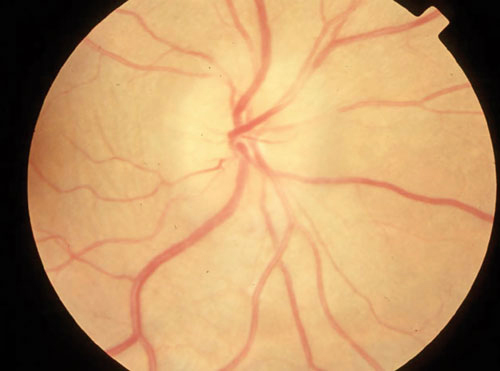 |
| Optic neuritis (pictured) was the most common ocular manifestation of MS in the study. Internuclear ophthalmoplegia and nystagmus were also fairly common in this MS cohort, whereas other neuro-ophthalmic and uveitic symptoms were less so. Photo: Joseph Sowka, OD. Click image to enlarge. |
Multiple sclerosis (MS) is the most common, chronic disabling central nervous system disorder in the demographic of young adults. With an estimated prevalence of two in 1,000 people worldwide and with an increased prevalence in Western countries, MS is a disease affecting no shortage of individuals.
A key manifestation of MS is ocular involvement that can result in significant disability and visual impairment. As such, researchers wanted to investigate the population-based frequency and severity of MS-related ocular diseases. Their retrospective study, published in Journal of Neuro-Ophthalmology, included 116 MS patients who were examined between 1998 and 2011. Patients were identified using the Rochester Epidemiology Project, an EHR-linking system of medical records for all patient-physician encounters in Olmsted County, Minnesota. MS diagnosis was confirmed with neuroimaging, cerebrospinal fluid studies and serum studies for each individual according to the 2017 McDonald criteria.
Totaling 116 patients, 66% of these were women and median onset age of MS was 36 years. Of this, 53% experienced MS-related neuro-ophthalmic manifestations during their disease course, with 28% showing visual symptoms as their presenting MS symptom; this was most commonly seen as optic neuritis (22%). Optic neuritis was also the leading MS-related ocular condition to develop over time (37%), followed by internuclear ophthalmoplegia (16%) and nystagmus (13%). Optic neuritis was unilateral in 93% of cases and only 16% had visual acuity of 20/200 or worse at the lowest point; however, 95% of optic neuritis cases resolving to visual acuity of 20/40 or better.
In their discussion, the study authors relay that their findings agree with previous studies documenting a primarily young female base of MS patients. They then elaborate on previous research done on optic neuritis prevalence and its conversion to MS, which has been estimated to be 20% to 50% after 20 years. However, previous research detailing the frequency of optic neuritis as a presenting MS symptom and its frequency during disease course is limited, with reported rates of 13% to 31% and 27% to 66%, respectively. These studies also lack information about other ocular manifestations seen with MS.
Finally, the authors add that their findings of typical MS-related optic neuritis being unilateral, retrobulbar and generally resulting in good visual outcomes is also reflective of previous studies.
With over one in two MS patients affected ocularly in this cohort, the authors stress that: “Our work underscores the importance of collaboration between neurologists and ophthalmologists for the diagnosis and management of patients with MS because several ophthalmologic manifestations of the disease may require treatment, such as prism for diplopia, or can be subtle and therefore missed without a detailed ophthalmic examination.”
They suggest “dedicated ocular examinations including orthoptics examination for ocular motor disorders and optic neuropathy testing (color plates, OCT and visual field examinations) are helpful both for making baseline diagnoses and for tracking disease progression.”
Kraker JA, Xu SC, Flanagan EP, et al. Ocular manifestations of multiple sclerosis: a population-based study. J Neuro-ophthalmol. March 8, 2024. [Epub ahead of print]. |


